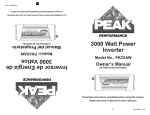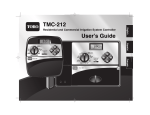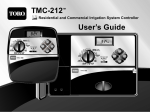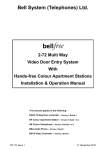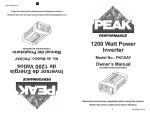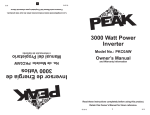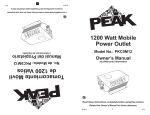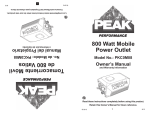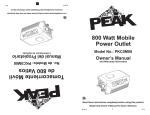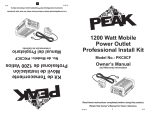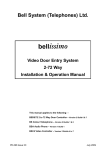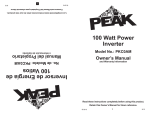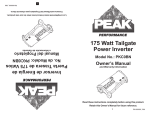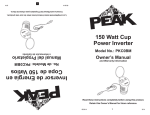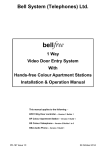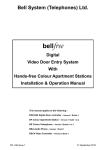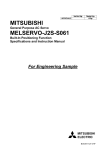Download Inversor de Energía de 2000 Vatios 2000 Watt
Transcript
1 P/N XXXXX, 06/09 Retain this Owner’s Manual for future reference. Read these instructions completely before using this product. TM e Información de Garantía Manual del Propietario 2000 Watt Power Inverter No. de Modelo: PKC0AX Model No.: PKC0AX Inversor de Energía de 2000 Vatios Owner’s Manual and Warranty Information TM Lea completamente estas instrucciones antes de usar este producto. Conserve este Manual del Propietario para referencia futura. P/N XXXXX, 06/09 1 ÍNDICE PRECAUCIONES DE SEGURIDAD................................................................................................. 2 Seguridad del Inversor de Energía.......................................................................................... 2 INTRODUCCIÓN.............................................................................................................................. 3 CARACTERÍSTICAS........................................................................................................................ 3 Operación.................................................................................................................................... 4 Determinación de Consumo de Energía.................................................................................. 4 Fuente de Energía................................................................................................................... 5 Determinación de la Capacidad de la Batería y Tiempo de Operación................................... 5 Posicionamiento del Inversor de Energía................................................................................ 5 Instalación Marina.................................................................................................................... 6 Conexión a la Fuente de Energía............................................................................................ 6 Conexión a una Batería de 12 voltios o 12 voltios CC con los Cables Suministrados.... 6 Alambrado Fijo a la Fuente de Energía................................................................................... 6 Determinación de la Longitud y Calibre Apropiados....................................................... 6 Instalación de los Cables................................................................................................ 7 Operación del Tomacorriente de Energía USB........................................................................ 8 Operación del Interruptor Remoto........................................................................................... 8 Indicador de Vatiaje de Potencia de Salida.............................................................................. 8 Conexión de una Carga al Inversor de Energía....................................................................... 8 Uso de la Batería............................................................................................................ 8 Características de Protección.................................................................................................. 9 Problemas Comunes............................................................................................................... 9 Cuidados y Mantenimiento................................................................................................... 10 Almacenaje............................................................................................................................ 10 Limpieza................................................................................................................................ 10 Descarte................................................................................................................................ 10 Especificaciones.................................................................................................................... 10 Resolución de Problemas.................................................................................................. 11 GARANTÍA LIMITADA.................................................................................................................... 12 Para Obtener Servicio............................................................................................................ 12 PRECAUCIONES DE SEGURIDAD Este símbolo de alerta de seguridad indica que está presente un peligro potencial de lesión personal. Este símbolo es usualmente usado con la palabra de señalamiento (por ejemplo, ADVERTENCIA) la cual designa el grado o nivel de seriedad del peligro. La palabra de señalamiento ADVERTENCIA indica una situación peligrosa que, si no se evita, puede resultar en la muerte o en lesiones serias. La palabra de señalamiento AVISO indica una situación que puede causarle daño al producto, otra propiedad personal y/o al medio ambiente, o causar que el producto funcione de manera incorrecta. La combinación del símbolo de alerta de seguridad y la palabra de señalamiento es usada en mensajes de seguridad a lo largo de este manual y etiquetas de seguridad en este producto. ADVERTENCIA Todos los mensajes de seguridad que siguen tiene niveles de seguridad de ADVERTENCIA. El no cumplir puede resultar en la muerte o en lesiones serias. Seguridad del Inversor de Energía • • • • • • • • • Este producto contiene plomo y/o compuestos con plomo, químicos conocidos en el Estado de California como causantes de cáncer y daños al sistema reproductivo. Lávese las manos después de manipularlos. MANTENGA EL INVERSOR DE ENERGÍA Y SUS ACCESORIOS FUERA DEL ALCANCE DE LOS NIÑOS. No use el Inversor de Energía con dispositivos médicos. No ha sido probado para aplicaciones médicas. No deje el vehículo desatendido mientras usa el Inversor de Energía. No opere el Inversor de Energía si los cables de la batería están dañados. Reemplace inmediatamente los cables dañados. Cuando use el Inversor, mantenga el Inversor de Energía, los cables de la batería y el cable del interruptor remoto alejados de los controles mecánicos del vehículo y sus componentes en rotación. No intente conectar el Inversor de Energía a la batería del vehículo mientras el motor esté encendido. No modifique de manera ninguna los cables de la batería. No opere el Inversor de Energía si ha recibido un golpe fuerte, se ha caído al suelo, o se ha dañado de cualquiera otra manera. 2 • This product contains lead and/or lead compounds, chemicals known to the state of California to cause cancer and reproductive harm. Wash hands after handling. • KEEP THE POWER INVERTER AND ITS ACCESSORIES OUT OF THE REACH OF CHILDREN. • Do not use the Power Inverter with medical devices. It is not tested for medical applications. • Do not leave the vehicle unattended while using the Power Inverter. • Do not operate the Power Inverter if the battery cables are damaged. Replace damaged battery cables immediately. • Keep the Power Inverter, battery cables and remote switch cable away from the vehicle’s mechanical controls and rotating components when using the Inverter. • Do not attempt to connect the Power Inverter to the battery of the vehicle while the engine is operating. • Do not modify the Inverter’s battery cables in any way. • Do not operate the Power Inverter if it has received a sharp blow, been dropped or been damaged in any other way. 2 Power Inverter Safety All safety messages that follow have WARNING level hazards. Failure to comply could result in death or serious injury. This safety alert symbol indicates that a potential personal injury hazard is present. The symbol is usually used with a signal word (e.g., WARNING) which designates the degree or level of hazard seriousness. The signal word WARNING indicates a hazardous situation which, if not avoided, could result in death or serious injury. The signal word NOTICE indicates a situation which can cause damage to the product, other personal property and/or to the environment, or cause the product to operate improperly. The combination of the safety alert symbol and signal word is used in safety messages throughout this manual and on safety labels on this product. SAFETY PRECAUTIONS SAFETY PRECAUTIONS................................................................................................................. 2 Power Inverter Safety............................................................................................................... 2 INTRODUCTION.............................................................................................................................. 3 FEATURES....................................................................................................................................... 3 Operation..................................................................................................................................... 4 Determining Power Consumption............................................................................................ 4 Power Source........................................................................................................................... 5 Determining Battery Capacity and Operating Time................................................................. 5 Positioning of Power Inverter................................................................................................... 5 Marine Installation.................................................................................................................... 6 Connecting to Power Source................................................................................................... 6 Connecting to 12-volt Battery or 12-volt DC Using Supplied Cables.............................. 6 Solid Wiring to Power Source.................................................................................................. 6 Determining Proper Cable Length and Gauge................................................................ 6 Installing Cables.............................................................................................................. 7 USB Power Outlet Operation................................................................................................... 8 Remote Switch Operation........................................................................................................ 8 Power Output Wattage Indicator.............................................................................................. 8 Connecting a Load to the Power Inverter................................................................................. 8 Battery Use..................................................................................................................... 8 Protective Features.................................................................................................................. 9 Common Problems.................................................................................................................. 9 Care and Maintenance.......................................................................................................... 10 Storage.................................................................................................................................. 10 Cleaning................................................................................................................................. 10 Disposal................................................................................................................................. 10 Specifications.......................................................................................................................... 10 Troubleshooting.................................................................................................................... 11 LIMITED WARRANTY.................................................................................................................... 12 To Obtain Service.................................................................................................................. 12 CONTENTS 3 11 14 13 12 Legend 1. Remote Switch 2. Remote Switch ON/OFF Button 3. Remote Switch Fault LED Indicator 4. Remote Switch Power LED Indicator 5. Red Positive (+) Screw Connectors (2) 6. Cooling Fans 7. Chassis Ground Connector 8. Black Negative (-) Screw Connectors (2) Red Positive (+) Battery Cables (2) Black Negative (-) Battery Cables (2) Power Output Wattage Indicator USB Power Outlet ON/OFF Switch Remote Switch Outlet Connection North American Standard 110/120-volt AC Receptacles (3) 16. FAULT/POWER Indicator 17. Remote Switch Connector 9. 10. 11. 12. 13. 14. 15. 15 10 16 8 17 • No desarme el Inversor de Energía. No hay componentes reemplazables dentro del Inversor. • NO instale u opere el Inversor de Energía en áreas designadas como PROTEGIDAS DE IGNICIÓN. El Inversor NO HA SIDO APROBADO para áreas protegidas de ignición. • Siempre gire el interruptor de ON/OFF y el botón de ON/OFF del interruptor remoto a la posición OFF y desconecte los cables de batería de la batería o fuente de energía cuando no esté siendo usado con el fin de evitar drenar la batería. • No exponga el Inversor a productos inflamables, agua, lluvia o nieve. • Use el Inversor sólo en áreas ventiladas apropiadamente. • Siempre remueva el enchufe del aparato de la toma de corriente CA antes de trabajar en el aparato. • No inserte objetos extraños dentro de las tomas de corriente CA. INTRODUCCIÓN Este Inversor de Energía se puede usar como fuente de alimentación y fuente de reserva para electrodomésticos y alimentar equipos recreativos con los requisitos de energía normales de hasta 2000 vatios continuos usando una conexión de energía de 12 voltios. • Cuando use el Inversor de Energía en un vehículo, consulte el manual del propietario del vehículo para obtener la capacidad de energía máxima y la salida recomendada. • Lea y comprenda este Manual de Instrucciones antes de usar el Inversor de Energía. • Instale y opere el Inversor de Energía sólo como se describe en este Manual de Instrucciones. CARACTERÍSTICAS 9 Compact design for safer use, transport and storage Connects to a 12-volt battery or power source Three North American Standard 110/120-volt AC receptacles LED operation indicator ON/OFF switch Remote switch USB port Load output indication Low voltage alarm Low voltage shutdown Overload protection High input voltage protection Thermal protection Mounting brackets for solid mounting 3 4 7 2 6 1 5 F ON / OF R ON INVE RTE H ITC OTE SW REM • • • • • • • • • • • • • • • • • • • • • • • • • • • • Diseño compacto para uso, transporte y almacenaje seguros Se conecta a una batería de 12 voltios o fuente de energía Tres receptáculos de 110/120 voltios CA de Estándar Norteamericano Indicador de operación LED Interruptor de ON/OFF Interruptor Remoto Puerto USB Indicación de carga de salida Alarma de bajo voltaje Apagado de bajo voltaje Protección de sobre carga Protección contra voltaje de entrada alto Protección térmica Soportes de montaje para montaje fijo 3 4 7 6 1 2 REM OTE SW ITC INVE H RTE R ON ON 5 / OF F 9 FEATURES 17 This Power Inverter can be used to supply power and emergency backup power for household appliances and power recreational equipment with a normal power requirement of up to 2000 continuous watts using a 12-volt power connection. • When using the Power Inverter in a vehicle, check the vehicle’s owner’s manual for maximum power rating and recommended output. • Read and understand this Instruction Manual before using the Power Inverter. • Install and operate the Power Inverter only as described in this Instruction Manual. 8 16 10 15 INTRODUCTION 14 13 12 • Do not disassemble the Power Inverter. There are no serviceable components within the Inverter. • Do NOT install or operate the Power Inverter in areas designated as IGNITION PROTECTED. The Inverter is NOT APPROVED for ignition protected areas. • Always turn the Inverter ON/OFF switch and remote switch ON/OFF button to the OFF position and disconnect the battery cables from the battery or power source when not in use to avoid draining the battery. • Do not expose the Inverter to flammables, water, rain or snow. • Use the Inverter in properly ventilated areas only. • Always remove the appliance plug from the AC receptacle before working on the appliance. • Do not insert foreign objects into the AC receptacles. 11 Leyenda 1. Interruptor Remoto 2. Botón de ON/OFF del Interruptor Remoto 3. Indicador LED de Falla del Interruptor Remoto 4. Indicador LED de Energía del Interruptor Remoto 5. Conectores de Tornillo (2) del Positivo (+) Rojo 6. Ventiladores de Enfriamiento 7. Conector de Tierra del Chasis 8. Conectores de Tornillo (2) del Negativo (–) Negro 9. Cables de Batería (2) Positivo (+) Rojo 10. Cables de Batería (2) Negativo (–) Negro 11. Indicador de Vatiaje de Potencia de Salida 12. Salida de Energía USB 13. Interruptor de ON/OFF 14. Conexión de Tomacorriente del Interruptor Remoto 15. Receptáculos de 110/120 voltios CA de Estándar Norteamericano (3) 16. Indicador de FALLA/ENERGÍA 17. Conector del Interruptor Remoto 3 OPERACIÓN El Inversor de Energía convierte voltaje de entrada de 12 voltios CC (corriente continua) a energía de 110/120 voltios, 60 Hz CA (corriente alterna). El inversor produce una “onda senoidal modificada.” La onda senoidal modificada es adecuada para la mayoría de los electrodomésticos de corriente CA y dispositivos electrónicos personales. Pueda que los siguientes dispositivos no trabajen con una onda senoidal modificada: • Fotocopiadoras, impresoras láser, discos duros óptico-magnéticos • Algunas computadoras portátiles • Luces de arco haluro de metal (MHI) • Algunas luces fluorescentes con balastros electrónicos • Herramientas motorizadas que usan energía de estado sólido • Ventiladores y herramientas motorizadas que usan controles de velocidad variable • Algunos hornos y estufas de aglomerados con control por microprocesador • Radios y relojes digitales • Maquinas de coser con control de velocidad por microprocesador • Electrónica que modula señales de frecuencia radial en la línea CA • Sistemas de automatización doméstica X-10 • Concentradores de oxígeno y otros equipos médicos La mayoría de los cargadores de baterías se pueden conectar al receptáculo de CA. Los cargadores de baterías que usan transformadores separados o cargadores que se enchufan en el receptáculo CA para proporcionar salida de bajo voltaje CC a CA deben trabajar. Sin embargo, cargadores de baterías para baterías de níquel cadmio se pueden dañar si son enchufados en el Inversor. Los siguientes electrodomésticos o dispositivos se pueden dañar si son enchufados en el Inversor: • Electrodomésticos pequeños operados a batería que se puede enchufar directamente al receptáculo CA, tales como linternas, afeitadoras inalámbricas y cepillos de dientes. • Ciertos cargadores de baterías para paquetes de baterías de herramientas inalámbricas. Estos cargadores se pueden identificar por una etiqueta de advertencia que dice que voltajes peligrosos están presentes en los terminales de la batería. AVISO Monitoree la temperatura del cargador de baterías durante 10 minutos. Si el cargador de baterías se calienta de forma anormal, desconéctelo inmediatamente del Inversor de Energía. Si usted no está seguro de enchufar algún electrodoméstico o aparato en el Inversor, contacte al fabricante o consulte el manual del propietario del dispositivo. Determinación de Consumo de Energía ADVERTENCIA PELIGRO DE FUEGO No opere con este Inversor electrodomésticos de alto voltaje o equipos que produzcan calor, tales como secadores de cabello, planchas, calentadores y tostadoras. AVISO Asegúrese de que el consumo de energía total del dispositivo que se esté usando sea inferior a la capacidad del Inversor. El fabricante suministra con este producto una etiqueta con la información de consumo de energía en vatios o amperios. Si el consumo de energía del aparato no se indica en vatios, pero en amperios CA, multiplique el valor de amperios CA por 120 (voltios CA) para determinar el vatiaje. AVISO Cuando encienda un electrodoméstico o aparato, el necesitará para arrancar el doble del vatiaje clasificado del electrodoméstico o dispositivo. Esto se conoce como la “carga de arranque” o “carga máxima.” Para determinar la carga de arranque o la carga máxima, multiplique el vatiaje clasificado por dos. Si ésta excede el incremento súbito del Inversor (4000 vatios [0.1 seg.]), no opere el electrodoméstico o aparato con el Inversor. El Inversor de Energía puede operar un aparato de carga resistente o un aparato de carga inductiva. La operación de un aparato de carga resistente es la más fácil para el Inversor. Sin embargo, el Inversor no operará aparatos de carga resistente grandes, tales como estufas eléctrica o calentadores. La carga resistente requiere un vatiaje más alto de el que produce el Inversor. Los televisores y estéreos son aparatos de carga inductiva (aparatos con una bobina o transformador). Ellos podrán necesitar más corriente de operación que un aparato de carga resistente con la misma capacidad de vatiaje. Algunos motores de inducción usados en congeladores, bombas y otros equipos operados a motor requieren corrientes de incremento súbito altas para arrancar. Pueda que el Inversor no pueda arrancar algunos de estos motores aunque su consumo de corriente esté dentro de los límites del Inversor. El Inversor arrancará normalmente motores monofásicos de 3/4 de caballo o inferiores. Si algún motor se niega a arrancar, asegúrese de que las conexiones de la batería estén buenas y que la batería esté completamente cargada. Si las conexiones están buenas y la batería está cargada, pueda que usted necesite usar una batería más grande o cables de entrada CC de mayor calibre y/o más cortos. 4 When you turn on an appliance or device, it will require twice the rated wattage of the appliance or device to start. This is known as the “starting load” or “peak load.” To determine the starting load or peak load, multiply the rated wattage by two. If this exceeds the peak surge output of the Inverter (4000 watts [0.1 sec]), do not operate the appliance or device with the Inverter. The Power Inverter can operate a resistive load device or an inductive load device. Operating a resistive load device is the easiest for the Inverter. However, the Inverter will not operate larger resistive load devices such as electric stoves and heaters. Their resistive load requires higher wattage than the Inverter can produce. TVs and stereos are inductive load devices (devices with a coil or transformer). They may require more current to operate than a resistive load device of the same wattage rating. Some induction motors used in freezers, pumps and other motor-operated equipment require highsurge currents to start. The Inverter may not be able to start some of these motors even though their rated current draw is within the Inverter’s limits. The Inverter will normally start single-phase motors rated at 3/4 hp or less. If a motor refuses to start, make sure that the battery connections are good and that the battery is fully charged. If the connections are good and the battery is charged, you may need to use a larger battery or DC input cables that are larger gauge and/or shorter length. 4 Ensure that total power consumption of the device being used is less than the rating of the Inverter. The manufacturer provides a label with power consumption information in watts or amps for their product. If the item’s power consumption is not indicated in watts, but in amps AC, multiply the amp AC value by 120 (AC volts) to determine the wattage. FIRE HAZARD Do not operate high wattage appliances or equipment that will produce heat, such as hair dryers, irons, heaters and toasters, with this Inverter. Determining Power Consumption Monitor the temperature of the battery charger for about 10 minutes. If the battery charger becomes abnormally warm, disconnect it from the Power Inverter immediately. If you are unsure about powering any appliance or device with the Inverter, contact the manufacturer or consult the owner’s manual of the device. • C ertain battery chargers for cordless tool battery packs. These chargers can be identified by a warning label stating dangerous voltages are present at the battery terminalss. The following appliances or devices could be damaged if plugged into the Inverter: • Small battery operated appliances that can be plugged directly into the AC receptacle such as flashlights, cordless razors and toothbrushes. Most battery chargers can be connected to the AC receptacle. Battery chargers that use separate transformers or chargers that plug into the AC receptacle to supply a low-voltage DC-to-AC output should work. However, battery chargers for small nickel-cadmium batteries can be damaged if plugged into the Inverter. The Power Inverter converts 12-volt DC (direct current) input voltage to 110/120-volt, 60 Hz AC (alternating current) power. The Inverter produces a “modified sine wave.” The modified sine wave is suitable for most AC powered appliances and personal electronic devices. The following devices may not work with a modified sine wave: • Photocopiers, laser printers, magneto-optical hard drives • Some laptops • Metal halide arc (MHI) lights • Some fluorescent lights with electronic ballasts • Power tools that use solid-state power • Fans and power tools that use variable speed controls • Some new furnaces and pellet stoves with microprocessor control • Digital radios and clocks • Sewing machines with speed/microprocessor control • Electronics that modulate radio frequency signals on the AC line • X-10 home automation systems • Oxygen concentrators and other medical equipment OPERATION 5 FIRE HAZARDS • Do not place the Inverter near flammable materials or in any location that may accumulate flammable fumes or gases such as the battery compartment of your vehicle or engine compartment of your boat. Position the Power Inverter on a reasonably flat surface. DO NOT place on or under the vehicle seats. Allow at least 3 in. (76 mm) of clearance around the Inverter to allow for airflow. Always use the Inverter where there is adequate ventilation. Do not block ventilation slots or the cooling fans. Install the Inverter as close to the DC power source as possible. It is more efficient to use longer AC wiring than DC wiring. If desired, the Power Inverter can be solidly mounted to a base using the mounting brackets. If installed in a vehicle, it is recommended that the Inverter be shock mounted using a rubber isolation pad between the Inverter and the base. The Inverter can be mounted on a vertical surface, on a horizontal surface or under a horizontal surface. Install the Inverter so that the receptacles and the ON/OFF switch are accessible. Do not install the Inverter on a vertical surface where the cooling fans are facing up or down. Positioning of Power Inverter Use conservative estimates when selecting a battery. The number of amp-hours you expect to use should be 50% of the battery’s rated amp-hours. There is no accurate conversion formula for converting CCA (cold cranking amps) into battery amp-hours. There are too many variations between battery manufacturers to have a standard formula. To determine the amp-hours for your battery, contact the battery manufacturer. To increase the operating time, the amp-hour rating must be increased. Either choose a battery with a higher amp-hour rating, or connect multiple batteries together in parallel. If the 12-volt DC battery has a rating of 200 amp-hours, connecting two 12-volt DC batteries, each having a 200 amp-hour rating in a parallel arrangement, would increase the amp-hour rating to 400 amp-hours, doubling the time of operation. 1600 (example of total wattage) ÷ 120 (AC volts) = 13.33 amps 200 (amp-hour rating of DC battery) ÷ 10 (always use 10) = 20 amp-hours @ 120 volts AC 20 (amp-hours @ 120 volts AC) ÷ 13.33 (amps) = 1.5 hours of operating time To determine your battery capacity, you will need to know the wattage of each appliance and/or tool that will be simultaneously powered by the Inverter. Keep in mind to add 15% to the wattage of each appliance and/or tool due to efficiency loss using the Inverter. Once you have determined the total wattage, use the following formula to determine the battery capacity in amp-hours and the operating time between charges. For this example, we will use a 12-volt DC battery rated at 200 amp-hours. Determining Battery Capacity and Operating Time Do not exceed the maximum input voltage of 15 volts DC. The Inverter could be damaged. The Power Inverter is for 12-volt battery systems only. A 6-volt battery system will not provide adequate input voltage and a 24-volt battery system will damage the Inverter. The Power Inverter can be connected to a 12-volt battery, multiple 12-volt batteries connected in parallel for heavy-duty installations or a regulated 12-volt DC power source. The power source must provide between 10.5 and 15 volts DC and must be able to provide sufficient current (in amperes) to operate multiple devices. Power Source • • • • • • 19” color TV Power drill Computer system 8-cup coffeemaker Microwave oven Furnace fan 100 watts 400 watts 400 watts 600 watts 900 watts 1100 watts • • • • • Electric skillet Refrigerator/freezer 7-1/4" circular saw Toaster oven Sump pump 1200 watts 1200 watts 1500 watts 1500 watts 1700 watts The following is a list of typical wattages of various appliances (the below wattage ratings are estimates only): La siguiente es una lista de vatiajes típicos de diferentes electrodomésticos ( las clasificaciones de vatiaje indicadas abajo son sólo estimados): • • • • • • TV a colores de 19" Taladro eléctrico Computadora Cafetera de 8 tazas Horno microondas Ventilador de horno 100 vatios 400 vatios 400 vatios 600 vatios 900 vatios 1100 vatios • • • • • Parrillas eléctricas Refrigerador-congelador Sierra circular de 7-1/4" Horno tostador Bomba colectora 1200 vatios 1200 vatios 1500 vatios 1500 vatios 1700 vatios Fuente de Energía El Inversor de Energía puede ser conectado a una batería de 12 voltios, múltiples baterías de 12 voltios conectadas en paralelo para instalaciones de trabajo pesado o a una fuente de energía regulada de 12 voltios CC. La fuente de energía debe suministrar entre 10.5 y 15 voltios CC y deberá ser capaz de suministrar corriente suficiente (en amperios) para operar múltiples dispositivos. AVISO No exceda el voltaje de entrada máximo de 15 voltios CC. El Inversor se puede dañar. AVISO El Inversor de Energía es para sistemas de batería de 12 voltios únicamente. Un sistema de batería de 6 voltios no suministrará voltaje de entrada adecuado y un sistema de batería de 24 voltios dañará el Inversor. Determinación de la Capacidad de la Batería y Tiempo de Operación Para determinar la capacidad de su batería, usted necesita saber el vatiaje de cada electrodoméstico y/o herramienta que será operada simultáneamente por el Inversor. Tenga en cuenta que se debe agregar el 15% al vatiaje de cada electrodoméstico y/o herramienta por causa de la pérdida de eficiencia al usar el Inversor. Una vez determinado el vatiaje total, use la siguiente fórmula para determinar la capacidad de la batería en amperios-hora y el tiempo de operación entre cargadas. Para este ejemplo, usaremos una batería de 12 voltios CC con una capacidad de 200 amperios-hora. 1600 (ejemplo del vatiaje total) ÷ 120 (voltios CA volts) = 13,33 amperios 200 (capacidad de amperios-hora de la batería CC) ÷ 10 (siempre use 10) = 20 amperios-hora @ 120 voltios CA 20 (amperios-hora @ 120 voltios CA) ÷ 13,33 (amperios) = 1,5 horas de tiempo de operación Para aumentar el tiempo de operación, la capacidad de amperios-hora tiene que ser aumentada. Seleccione una batería con una capacidad de amperios-hora más alta o conecte múltiples baterías en paralelo. Si la batería de 12 voltios CC tiene una capacidad de 200 amperios-hora, al conectar dos baterías de 12 voltios CC, cada una con capacidad de 200 amperios-hora conectadas en paralelo, aumentará la capacidad a 400 amperios-hora, doblando el tiempo de operación. Use estimados conservadores al seleccionar una batería. El número de amperios-hora que usted espera usar deberá ser el 50% de la capacidad de la batería en amperios-hora. AVISO No hay una fórmula de conversión precisa para convertir CCA (amperios de arranque en frío) en amperios-hora de batería. Hay demasiadas variaciones entre los fabricantes de baterías para tener una formula estándar. Para determinar el amperaje-hora de su batería, póngase en contacto con el fabricante. Posicionamiento del Inversor de Energía Posicione el Inversor de Energía sobre una superficie razonablemente plana. NO lo posicione sobre o debajo de los asientos del vehículo. Deje por lo menos 3 pul. (76 mm) de espacio libre alrededor del Inversor para permitir el flujo de aire. Siempre use el Inversor donde haya ventilación adecuada. No bloquee las ranuras de ventilación o los ventiladores de enfriamiento. Instale el Inversor tan cerca como sea posible a la fuente de energía CC. Es más eficiente usar cables CA más largos que cables CC. Si así lo desea, el Inversor de Energía se puede montar sólidamente a una base usando los soportes de montaje. AVISO Si lo instala en un vehículo, se recomienda que el Inversor sea montado usando una almohadilla de caucho aislante entre el Inversor y la base. El Inversor se puede montar sobre una superficie vertical, horizontal o debajo de una superficie horizontal. Instale el Inversor de modo que los receptáculos y el interruptor de ON/OFF queden accesibles. AVISO No instale el Inversor sobre una superficie vertical donde los ventiladores de enfriamiento queden de cara hacia arriba o hacia abajo. ADVERTENCIA PELIGROS DE FUEGO • No coloque el Inversor cerca de materiales inflamables o en cualquier ubicación donde se acumulen gases inflamables tales como el compartimiento de baterías de su vehículo o el compartimiento del motor de su bote. 5 • No exponga el Inversor a calor extremo o llamas. La temperatura del aire circundante deberá estar entre 32° y 104°F (0° y 40°C). No coloque el Inversor sobre o cerca de una salida de calefacción o de cualquier equipo que esté generando calor más arriba de la temperatura ambiente. No coloque el Inversor directamente bajo la luz solar. ADVERTENCIA PELIGRO DE ELECTROCUCIÓN No opere el Inversor si está mojado. No permita que el Inversor entre en contacto con agua, humedad u otros líquidos, con el aparato que se está operando o con la fuente de energía. Instalación Marina AVISO Las instalaciones marinas están sujetas a más vibración y estrés en los cables. Las instalaciones marinas requieren conexiones eléctricas resistentes al agua con holgura en los cables y alambres del aparato. Use el aislamiento de cable apropiado para el medio ambiente. Instale el Inversor de Energía alejado de la humedad y del agua. Instale el Inversor por encima de la línea de flotación, tan alto como sea posible. El Inversor no se deberá instalar por debajo o cerca de la línea de flotación. La entrada CC al Inversor se tiene que conectar con cables marinos aprobados, usando acoples y sujetadores marinos no corrosivos. Conexión a la Fuente de Energía ADVERTENCIA PELIGRO DE INCENDIO No conecte el Inversor a un Vehículo Recreativo (RV) o al sistema de distribución CA de la casa, a un circuito de carga CA o donde el conductor neutro esté conectado al terminal negativo de una fuente de energía CC. El conectarlo a estos circuitos podrá causarle daños al Inversor y/o crear una chispa. AVISO No lo use en sistemas eléctricos de tierra positiva. El conectar el Inversor a un sistema eléctrico de tierra positiva dañará el Inversor. Sólo use el Inversor de Energía en sistemas eléctricos de tierra negativa. Si tiene duda, consulte con el distribuidor de su vehículo o lea el manual del propietario del vehículo. Conexión a una Batería de 12 voltios o 12 voltios CC con los Cables Suministrados El Inversor de Energía está equipado con cuatro conectores de tornillo, dos positivos (+) y dos negativos (–) para sujetar los cables al Inversor. El rojo es positivo (+) y el negro es el negativo (-). 1. Oprima el interruptor de ON/OFF y el botón del interruptor remoto ON/OFF a la posición OFF. 2. Remueva las dos tapas de los dos conectores de tornillo positivo (+) rojo y las arandelas de seguridad. 3. Deslice la arandela de seguridad, luego el cable positivo (+) con el agujero de menor diámetro, en el espárrago del tornillo positivo (+) rojo. Apriete seguramente la tapa del conector del tornillo. Repita para el otro cable positivo (+). 4. Remueva las dos tapas de los dos conectores de tornillo negativo (–) negro y las arandelas de seguridad. 5. Deslice la arandela de seguridad, luego el cable negativo (–) negro con el agujero de menor diámetro en el espárrago del tornillo negativo (–) negro. Apriete seguramente la tapa del conector del tornillo. Repita para el otro cable negativo (–). 6. Conecte seguramente ambos cables positivos (+) rojos con el agujero de diámetro mayor al terminal positivo (+) de la batería o fuente de energía. 7. C onecte seguramente ambos cables negativos (–) negros con el agujero de diámetro mayor al terminal negativo (–) de la batería o fuente de energía. Alambrado Fijo a la Fuente de Energía El Inversor de Energía se puede alambrar sólidamente a la fuente de energía CC. Se debe instalar un fusible de 300 amperios ANL o un disyuntor CC para proteger el circuito. Determinación de la Longitud y Calibre Apropiados Mida la distancia entre el Inversor de Energía y la fuente de energía. Consulte las ESPECIFICACIONES para obtener el calibre del cable que se debe usar. El usar cables excesivamente largos o de calibre insuficiente reducirá la energía de la batería. También, el uso de cables inapropiados reducirá el tiempo de operación de la batería. AVISO Use únicamente cables de cobre para conectar el Inversor de Energía a la fuente de energía. No use cables de aluminio. Los cables de aluminio tienen aproximadamente 1/3 más de resistencia que los cables de cobre del mismo tamaño. AVISO Use solamente conectores de cable del tamaño apropiado para conectar los cables al Inversor y a la fuente de energía. Asegúrese de que los conectores de los cables sean instalados apropiadamente en los extremos de los cables. 6 Determining Proper Cable Length and Gauge Measure the distance between the Power Inverter and the power source. Refer to SPECIFICATIONS for the proper cable gauge to use. Using excessively long or insufficient gauge cables will cause low battery power. Also, using improper cables will reduce battery operation time. Only use copper cables to connect the Power Inverter to the power source. Do not use aluminum cables. Aluminum cables have approximately 1/3 more resistance than copper cables of the same size. Only use proper size cable connectors to connect the cables to the Inverter and power source. Be sure the cable connectors are properly installed onto the ends of the cables. The Power Inverter can be solid wired to the DC power source. A 300-amp ANL fuse or DC circuit breaker should be installed to protect the circuit. Solid Wiring to Power Source FIRE HAZARD Do not connect the Inverter to RV or household AC distribution wiring, to an AC load circuit or where the neutral conductor is connected to the negative terminal of a DC power source. Connecting to these circuits could cause damage to the Inverter and/or create a spark. Do not use with positive ground electrical systems. Connecting the Inverter to a positive ground electrical system will damage the Inverter. Only use the Power Inverter on negative ground electrical systems. If in doubt, check with your vehicle dealer or consult the vehicle’s owner’s manual. Connecting to 12-volt Battery or 12-volt DC Using Supplied Cables The Power Inverter is equipped with four screw connectors, two positive (+) and two negative (-) to attach the cable leads to the inverter. The red is positive (+) and the black is negative (-). 1. Press the ON/OFF switch and remote switch ON/OFF button to the OFF position. 2. Remove the two red positive (+) screw connector caps and the lock washers. 3. Slide the lock washer, then the red positive (+) cable lead with the smaller hole diameter, onto the red positive (+) screw connector stud. Tighten the screw connector cap securely. Repeat for the other positive (+) cable. 4. Remove the two black negative (-) screw connector caps and the lock washers. 5. Slide the lock washer, then the black negative (-) cable lead with the smaller hole diameter, onto the black negative (-) screw connector stud. Tighten the screw connector cap securely. Repeat for the other negative (-) cable. 6. Securely connect both red positive (+) cable leads with the larger hole diameter to the positive (+) terminal of the battery or power source. 7. Securely connect both black negative (-) cable leads with the larger hole diameter to the negative (-) terminal of the battery or power source. Connecting to Power Source Marine installations are subject to additional vibration and stress on the cables. Marine installations require tight, water-resistant electrical connections with slack in both the cables and appliance wiring. Use the appropriate cable insulation for the environment. Install the Power Inverter away from moisture and water. Install the Inverter above the waterline, as high as possible. The Inverter must not be installed below or near the waterline. The Inverter’s DC input must be connected to approved marine wiring using non-corrosive marine fasteners and fittings. Marine Installation ELECTROCUTION HAZARD Do not operate the Inverter if it is wet. Do not allow water, moisture or other liquids to come in contact with the Inverter, the device being operated or the power source. • D o not expose the Inverter to extreme heat or flames. The surrounding air temperature should be between 32° and 104°F (0° and 40°C). Do not place the Inverter on or near a heating vent or any equipment which is generating heat above room temperature. Do not place the Inverter in direct sunlight. 6 7 Legend 1. Battery Charging Source 2. 12-volt Batteries 3. 300-amp ANL Fuse 4. Power Inverter 5. Negative (-) Cable (see SPECIFICATIONS for cable requirements) 6. Positive (+) Cable (see SPECIFICATIONS for cable requirements) 7. Additional Batteries Connected in Parallel Circuit OWI_0119 2 7 5 2 6 2 4 Instalación de los Cables 1. Oprima el interruptor de ON/OFF y el botón del interruptor remoto ON/OFF a la posición OFF. 2. Instale el fusible de 300 amperios ANL o el disyuntor CC en el terminal positivo (+) de la fuente de energía. Retire el fusible del porta fusible antes de instalar el porta fusible o apague el disyuntor. Si el porta fusible o el disyuntor no pueden ser instalados en el terminal, use un pedazo de cable corto del calibre recomendado para conectar el porta fusible o el disyuntor en el terminal. Identifique este cable como el positivo (+). 3. Asegure el otro extremo del porta fusible o disyuntor a los cables positivos (+). Conecte los cables positivos (+) al conector de tornillo positivo rojo en el Inversor. Coloque las arandelas entre los conectores de los cable y los conectores de tornillo. Apriete seguramente los conectores de tornillo. 4. Conecte los cables negativos entre el terminal negativo (–) de la fuente de energía y los conectores de tornillo negativos (–) negros en el Inversor. Coloque las arandelas entre los conectores de los cable y los conectores de tornillo. Apriete seguramente los conectores de tornillo. 5. Conecte un cable de calibre No. 12 AWG (Calibre de Cable Americano) o un cable aislado más grueso en el Inversor y en un punto de tierra limpio del vehículo. Esto disminuirá el posible ruido de interferencia eléctrico al usar la televisión o la radio. AVISO No conecte el cable de tierra al terminal negativo (–) de la fuente de energía. Sólo conecte este cable a un punto de tierra limpio en el vehículo. ADVERTENCIA PELIGRO DE INCENDIO Verifique que todas las conexiones están seguras. Una conexión floja podrá causarle daños al Inversor y/o crear una chispa. 6. Verifique que los cables positivos (+) estén conectados entre el terminal positivo (+) de la fuente de energía y los conectores de tornillo positivos (+) rojos en el Inversor. También, verifique que los cables negativos (–) estén conectados entre el terminal negativo (–) de la fuente de energía y los conectores de tornillo negativos (–) negros en el Inversor. AVISO Si los cables no están correctamente conectados, el Inversor de Energía se dañará. 7. Instale el fusible en el porta fusible o encienda el disyuntor. 3 1 1 3 Installing Cables 1. Press the ON/OFF switch and remote switch ON/OFF button to the OFF position. 2. Install the 300-amp ANL fuse or DC circuit breaker onto the positive (+) terminal of the power source. Remove the fuse from the fuse holder before installing the fuse holder or turn off the circuit breaker. If the fuse holder or circuit breaker cannot be installed onto the terminal, use a short length of the recommended cable gauge to connect the fuse holder or circuit breaker to the terminal. Identify this cable as positive (+). 3. Secure the remaining end of the fuse holder or circuit breaker to the positive (+) cables. Connect the positive (+) cables to the red positive screw connectors on the Inverter. Position the washers between the cable connectors and the screw connectors. Tighten the screw connectors securely. 4. Connect the negative cables between the negative (-) terminal of the power source and the black negative (-) screw connectors on the Inverter. Position the washers between the cable connectors and the screw connectors. Tighten the screw connectors securely. 5. Connect a #12 AWG or larger insulated wire between the chassis grounding connector on the Inverter and a clean electrical grounding point on the vehicle. This will minimize possible electrical noise interference when using TVs or radios. Do not connect the grounding wire to the negative (-) terminal of the power source. Only connect this wire to a clean grounding point on the vehicle. FIRE HAZARD Verify that all connections are secured. A loose connection may cause damage to the Inverter and/or create a spark. 6. Verify that the positive (+) cables are connected between the positive (+) terminal of the power source and the red positive (+) screw connectors on the Inverter. Also, verify that the negative (-) cables are connected between the negative (-) terminal of the power source and the black negative (-) screw connectors on the Inverter. If the cables are not connected correctly, the Power Inverter will be damaged. 7. Install the fuse in the fuse holder or turn on the circuit breaker. 4 2 6 5 2 7 2 OWI_0119 Leyenda 1. Fuente de Carga de las Baterías 2. Baterías de 12 voltios 3. Fusible de 300 amperios ANL 4. Inversor de Energía 5. Cable Negativo (–) (consulte las ESPECIFICACIONES para obtener los requisitos de cable) 6. Cable Positivo (+) (consulte las ESPECIFICACIONES para obtener los requisitos de cable) 7. Baterías Adicionales Conectadas en Circuito Paralelo 7 Operación del Tomacorriente de Energía USB AVISO La salida de energía USB no apoya las comunicaciones de datos. La salida tiene un máximo de 5 voltios/500mA. 1. Enchufe el dispositivo USB-energizado dentro de la salida de energía USB. 2. Asegúrese de que el Inversor esté conectado correctamente a la batería. 3. Encienda el Inversor usando el interruptor de ON/OFF o el botón ON/OFF del interruptor remoto. 4. Encienda el dispositivo accionado por USB. 5. Al apagar, apague primero el dispositivo USB, luego apague el Inversor. 6. Desenchufe el dispositivo USB de la salida de energía USB. AVISO La salida de energía USB es una salida sin interruptor. Siempre que el Inversor esté conectado a una batería, habrá energía en la salida USB. El interruptor ON/OFF o el botón ON/OFF del interruptor remoto no necesitan estar encendidos para que haya energía en la salida USB. Operación del Interruptor Remoto AVISO El interruptor ON/OFF del Inversor tiene que estar en la posición OFF cuando se usa el interruptor remoto. Si el interruptor ON/OFF está en la posición ON, el interruptor remoto no operará. 1. Asegúrese de que el interruptor ON/OFF del Inversor está en la posición OFF. 2. Enchufe el conector del interruptor remoto en la toma del interruptor remoto en el Inversor. 3. Oprima el botón ON/OFF del interruptor remoto. La luz verde en el interruptor remoto y en el Inversor deberán estar encendidas. 4. Una vez que el Inversor ha sido encendido usando el interruptor remoto, la operación del Inversor será controlada usando el interruptor remoto. 5. Apague el Inversor usando el interruptor remoto antes de desconectar el conector del interruptor remoto del Inversor. Indicador de Vatiaje de Potencia de Salida El Inversor está equipado con un indicador de vatiaje de potencia de salida que indica cuanto vatiaje está siendo usado. El indicador de potencia de salida tiene diez luces separadas, cuando se prenden, cada una representa aproximadamente 200 vatios de salida. Si el dispositivo que usted esta alimentando requiere aproximadamente 1000 vatios, cinco de las luces indicadoras rojas estarán encendidas. Use estas luces como referencia para no sobrecargar el Inversor. Este Inversor puede ser sobrecargado fácilmente cuando se usan los tres tomacorrientes de 110/120 voltios CA. Si el primer dispositivo que usted esta alimentando muestra siete luces encendidas en el indicador (aproximadamente 1400 vatios) y el siguiente dispositivo que usted quiere alimentar requiere aproximadamente 800 vatios, usted no lo puede enchufar porque sobrecargará el Inversor. Use este indicador de potencia de salida como guía al alimentar sus dispositivos. Conexión de una Carga al Inversor de Energía Sólo conecte los electrodomésticos al Inversor de Energía después de que el Inversor haya sido conectado apropiadamente a la fuente de energía. 1. Oprima el interruptor de ON/OFF o el botón ON/OFF del interruptor remoto a la posición ON. El indicador de energía LED verde en el Inversor y/o en el interruptor remoto se prenderá de manera continua, indicando que la unidad está funcionando. 2. Enchufe el electrodoméstico o aparato en el receptáculo de 110/120 voltios CA. 3. Prenda el aparato. Si suena una alarma o si se prenden las luces de falla LED rojas durante un tiempo prolongado, el voltaje de la fuente de energía es muy bajo o la corriente que el aparato está demandando es demasiado alta. AVISO Monitoree la temperatura del aparato durante los primeros 10 minutos de operación para ver si se está calentando. Si la temperatura del aparato se torna demasiado caliente, es una indicación de que el aparato no se debe usar con este Inversor. 4. Cuando apague, primero apague la energía del electrodoméstico o del aparato. 5. Retire el enchufe de energía del receptáculo de 110/120 voltios CA del Inversor. 6. Gire el interruptor de ON/OFF del Inversor o el botón ON/OFF del interruptor remoto a la posición OFF. 7. Desconecte los cables de batería de la batería o fuente de energía. 8. Desconecte los cables de los conectores de tornillo. 9. Coloque las arandelas de seguridad y las tapas del conector de tornillo en los espárragos. Uso de la Batería Se recomienda que, si usted está usando una batería vehicular, usted debe operar el motor durante 15 minutos cada hora para recargar la batería. 8 Monitor the temperature of the device for the first 10 minutes of operation to determine its temperature. If the temperature of the device becomes excessively hot, it is an indication that the device should not be used with this Inverter. 4. When shutting down, first turn the power of the appliance or device off. 5. Remove the power plug from the Inverter’s 110/120-volt AC receptacle. 6. Turn the Inverter’s ON/OFF switch or remote switch ON/OFF button to the OFF position. 7. Disconnect the cable leads from the battery or power source. 8. Disconnect the cable leads from the screw connectors. 9. Place the lock washers and screw connector caps back onto the studs. Battery Use It is recommended that, if you are using a vehicle battery, you run the engine for 15 minutes every hour in order to recharge the battery. The Power Inverter may be used with the engine on or off. However, it may not operate while the engine is being started, as battery voltage can drop substantially during starting. Only connect appliances to the Power Inverter after the Inverter is properly connected to the power source. 1. Press the ON/OFF switch or remote switch ON/OFF button to the ON position. The green LED power indicator on the Inverter and/or remote switch will light continuously, indicating that the unit is functioning. 2. Plug the appliance or device into the 110/120-volt AC receptacle. 3. Switch on the device. If an audible alarm sounds or the red LED fault indicator lights up for a protracted period of time, then either the power source voltage is too low or the current being drawn by the device is too great. Connecting a Load to the Power Inverter The Inverter is equipped with a power output wattage indicator which displays how much wattage is currently being used. The output indicator has ten separate red lights, with each one representing approximately 200 watts of output when lit. If the device you are powering requires approximately 1000 watts, five of the red indicator lights will be lit. Use these lights as a reference so you do not overload the Inverter. This Inverter can be easily overloaded when using all three 110/120-volt AC outlets. If the first device you are powering shows seven lights on the indicator are lit (approximately 1400 watts) and the next device you want to power requires approximately 800 watts, you cannot plug that device in because it will overload the Inverter. Use this output indicator as a guide when powering your devices. Power Output Wattage Indicator The Inverter ON/OFF switch must be in the OFF position when using the remote switch. If the Inverter ON/OFF switch is in the ON position, the remote switch will not operate. 1. Make sure the Inverter ON/OFF switch is in the OFF position. 2. Plug in the remote switch connector into the remote switch outlet connection on the Inverter. 3. Press the remote switch ON/OFF button. The green light on the remote switch and on the Inverter should be lit. 4. Once the Inverter is turned on using the remote switch, the Inverter operation will be controlled using the remote switch. 5. Turn the Inverter off using the remote switch before disconnecting the remote switch connector from the Inverter. Remote Switch Operation The USB power outlet is an unswitched outlet. Whenever the Inverter is connected to a battery, there will be power to the USB outlet. The ON/OFF switch or the remote switch ON/OFF button does not need to be turned on to have power at the USB outlet. The USB power outlet does not support data communications. The outlet has a maximum of 5 volts/500mA. 1. Plug the USB-powered device into the USB power outlet. 2. Make sure the Inverter is correctly connected to the battery. 3. Turn on the Inverter using the ON/OFF switch or the remote switch ON/OFF button. 4. Turn on the USB-powered device. 5. When shutting down, turn off the USB device first, then turn the Inverter off. 6. Unplug the USB device from the USB power outlet. USB Power Outlet Operation 8 9 Power tools will start but will not continue to run - Some induction motors (motors without brushes) may require 2 to 6 times their wattage rating in order to start up. If the power tool runs only momentarily when power is applied, try to leave the power tool on while quickly and repeatedly turning the Inverter on and off. Buzzing in audio systems - Some inexpensive stereo systems will emit a buzzing sound from their speakers when operating from the Inverter. This is because the power supply in the device does not adequately filter the modified sine wave produced by the Inverter. Television interference - The Inverter is shielded and filtered to minimize interference with TV signals. In some cases, especially with weak TV signals, some interference may be visible. Try the following corrective measures: • Position the Inverter as far away as possible from the television, the antenna and the antenna cable. • Adjust the orientation of the Inverter, the antenna cable and the TV power cable to minimize interference. • Use high-quality, shielded antenna cable. Operating a microwave - The power rating used with microwave ovens is the “cooking power” which qualifies as the power being “delivered” to the food being microwaved. The actual operating power requirement rating is higher than the cooking power rating. This is usually referenced on the back of the microwave. If the operating power requirement cannot be found on the back of the microwave, check the owner’s manual or contact the manufacturer. Common Problems To Reset the Inverter 1. Turn off the Inverter using the ON/OFF switch on the Inverter or the remote switch ON/OFF button, depending upon how the Inverter was controlled. 2. Unplug all the devices from the Inverter. 3. Before turning Inverter back on, verify the total wattage of the devices being powered. 4. Turn the Inverter back on using the ON/OFF switch on the Inverter or the remote switch ON/OFF button. Temperature Protection The Inverter is equipped with two cooling fans. Depending upon the load output and the temperature of the Inverter, the cooling fans will turn on and off as required to cool the Inverter if needed. If the temperature reaches approximately 149°F (65°C) the Inverter will shut down automatically. Turn off the Inverter and allow it to cool for a minimum of 15 minutes. Before starting up again verify the total wattage of the devices being powered. Overload Protection (Red LED on Inverter and remote switch will light) The Inverter will automatically shut down if the continuous draw exceeds its maximum wattage rating. When the Inverter is at or near maximum output, an alarm will sound. When the alarm sounds you need to disconnect the device(s) from the Inverter to bring the Inverter output down to an acceptable level. If you continue to use the Inverter at or near the maximum output, it will eventually overheat and shut down. If you exceed the maximum Inverter output, the alarm will sound and the Inverter will automatically shut down. The red fault indicator on the Inverter will light and both fans will run. The Inverter must be reset after an overload condition. Low Voltage Alarm (Red LED on Inverter and remote switch will light) - This state is not harmful to the Inverter, but could damage the power source. An audible alarm sounds when the input voltage drops to 10.4 volts and the Inverter shuts off when the input voltage drops to 10.0 volts. When ample power is supplied, the Inverter may then be turned back on. Over-Voltage Protection (Red LED on Inverter and remote switch will light) - The Inverter will automatically shut down when the input voltage exceeds 15.5 volts DC. Protective Features The Inverter draws little current from the battery when it is not supplying power to a load. Typically, this Power Inverter draws less than 1.0 amps. It is recommended that you disconnect the Inverter from the battery when not in use. El Inversor de Energía se puede usar con el motor encendido o apagado. Sin embargo, no se debe usar mientras el motor está siendo arrancado, ya que el voltaje cae substancialmente durante la arrancada. El Inversor consume muy poca corriente de la batería mientras no está suministrando energía a un aparato. Típicamente, este Inversor de Energía consume menos de 1,0 amperios. Se recomienda que usted desconecte el Inversor de la batería cuando no esté siendo usado. Características de Protección Alarma de Bajo Voltaje (Luz roja en el Inversor y en el interruptor remoto encendidas) - Este estado no es dañino para el Inversor, pero podrá dañar la fuente de energía. Una alarma suena cuando el voltaje de entrada cae a 10.4 voltios y el Inversor se apaga cuando el voltaje de entrada cae a 10.0 voltios. Cuando se suministra energía amplia, el Inversor entonces se puede volver a encender. Protección de Sobre-Voltaje (LED rojo en el Inversor e interruptor remoto encendidos) - El Inversor se apagará automáticamente cuando el voltaje de entrada exceda los 15.5 voltios. Protección de Sobre Carga (LED rojo en el Inversor y en el interruptor remoto encendidos) El inversor se apagará automáticamente si el consumo continuo excede su máxima capacidad de vatiaje. Cuando el inversor se encuentra cerca, o al máximo de salida, una alarma sonará. Cuando la alarma suena, usted tiene que desconectar el(los) dispositivo(s) del Inversor para bajar la salida del Inversor a un nivel aceptable. Si usted continua usando el Inversor cerca o al máximo de salida, eventualmente se calentará y se apagará. Si usted excede la salida máxima del Inversor, la alarma sonará y el Inversor se apagará automáticamente. El indicador rojo de falla en el Inversor se encenderá y ambos ventiladores funcionarán. El Inversor tiene que ser reinicializado después de una condición de sobrecarga. Para reinicializar el Inversor 1. Apague el Inversor usando el interruptor ON/OFF en el Inversor o el botón ON/OFF del interruptor remoto, dependiendo de como estaba siendo controlado el Inversor. 2. Desenchufe todos los aparatos conectados al Inversor. 3. Antes de encender de nuevo el Inversor, verifique el vatiaje total de los dispositivos que serán alimentados. 4. Encienda de nuevo el Inversor usando el interruptor de ON/OFF en el Inversor o el botón ON/ OFF del interruptor remoto. Protección de Temperatura El Inversor está equipado con dos ventiladores. Dependiendo de la carga de salida y de la temperatura del Inversor, los ventiladores se encenderán y se apagarán como sea necesario para enfriar el Inversor. Si la temperatura alcanza aproximadamente 149°F (65°C) el Inversor se apagará automáticamente. Apague el Inversor y déjelo que se enfríe durante un mínimo de 15 minutos. Antes de arrancarlo de nuevo, verifique el vatiaje total de los dispositivos que serán alimentados. Problemas Comunes Las herramientas motorizadas arrancarán pero no continuarán funcionando - Algunos motores de inducción (motores sin escobillas) podrán necesitar de 2 a 6 veces más vatiaje para que arranquen. Si la herramienta motorizada trabaja momentáneamente cuando se le aplica energía, trate de dejar la herramienta prendida mientras que repetidamente prende y apaga el Inversor. Zumbido en los sistemas de audio - Algunos sistemas estéreo baratos emitirán un zumbido por los parlante cuando son operados en el Inversor. Esto es causado por que la fuente de energía del aparato no filtra adecuadamente la onda senoidal modificada producida por el Inversor. Interferencia con la televisión - El Inversor es blindado y filtrado para minimizar la interferencia con las señales de televisión. En algunos casos, especialmente con señales de televisión débiles, se puede ver alguna interferencia. Trate las siguientes medidas correctivas: • Coloque el Inversor tal lejos como sea posible de la televisión, antena y del cable de la antena. • Ajuste la orientación del Inversor, del cable de la antena y el cable de energía de la televisión para minimizar la interferencia. • Use cable de antena blindado de alta calidad. Operación de un microonda - La capacidad de energía usada en los hornos microonda es la “potencia de cocción” que califica como la energía que se esta “entregando” a los alimentos que se están cocinando en el microondas. La capacidad requerida de energía de operación es más alta que la capacidad de energía para cocinar. Esto es usualmente mencionado en la parte trasera del microondas. Si no puede ubicar el requisito de energía de operación en la parte trasera del microonda, consulte el manual del propietario o póngase en contacto con el fabricante. 9 CUIDADOS Y MANTENIMIENTO 10 Almacenaje Almacene este Inversor de Energía en una área fría y seca, alejado de la luz solar directa, el calor y la humedad excesiva. La temperatura de almacenaje debe ser entre –4°F y 185°F (–20°C y 85°C) con una humedad entre el 10% y el 90%. Limpieza No limpie o le pase un trapo con disolventes o materiales químicos al Inversor de Energía. Si es necesario, remueva la mugre o la manchas con un trapo suave humedecido en una solución de detergente suave. Descarte El Inversor de Energía fue diseñado para proporcionarle años de servicio. Puesto que el Inversor y los cables contienen plomo, ellos deberán ser reciclados o descartados seguramente en un centro de reciclaje local. Ejemplos de lugares que aceptan artículos como estos son: centros de reciclaje del condado o municipales o distribuidores de chatarra. ESPECIFICACIONES Voltaje de Entrada CC Voltaje de Salida CA Capacidad de Salida de Corriente Consumo de Corriente sin Carga Receptáculos CA 1. 2. 3. 4. 5. 6. 7. 8. 9. 10. 11. 12. 13. 14. 15. 11-15V 105-125V 16.6A ≤ 1.0A Tres de 110/120V CA Receptáculos Estándar Norteamericanos 5 voltios/500 mA 2000 Vatios 4000 Vatios (0.1 seg.) ≥ 85% ≤ 175A a 2000 Vatios Onda Senoidal Modificada 60Hz ± 3Hz 50°F a 86°F (10°C a 30°C) -4°F a 185°F (-20°C a 85°C) 10%-90% 300 ANL USB Port Maximum Continuous Power Peak Surge Output Efficiency Max. Current Consumption Signal Format/Output Working Temperature Storage Temperature Storage Air Humidity DC Fuse Requirement for Solid Wired Installation Supplied Cables Cable Requirement @ 6 ft (1.8 m) Cable Requirement @ 10 ft (3.0 m)* 3 pies (1 m) #6 AWG (2 conjuntos) #2 AWG (Calibre de Cable Americano) 00 AWG (Calibre de Cable Americano) 6. 7. 8. 9. 10. 11. 12. 13. 14. 15. 16. 17. 18. 105-125V 16.6A ≤ 1.0A Three 110/120V AC North American Standard Receptacles 5 volts/500 mA 2000W 4000 Watts (0.1 Sec) ≥ 85% ≤ 175A at 2000W Modified Sine Wave 60H3hz 50°F to 86°F (10°C to 30°C) -4°F to 185°F (-20°C to 85°C) 10%-90% 300 ANL 3 ft (1 m) #6 AWG (2 sets) #2 AWG 00 AWG 11-15V Puerto USB Energía Continua Máxima Incremento Súbito de Salida Eficiencia Consumo de Corriente Máximo Formato de Señal/Salida Temperatura de Trabajo Temperatura de Almacenaje Humedad del Aire de Almacenaje Fusible CC Requerido para Instalación de Alambrado Fijo Cables Suministrados Requisitos del Cable @ 6 pies (1,8 m) Requisitos del Cable @ 10 pies (3,0 m)* DC Input Voltage AC Output Voltage Current Output Rating No Load Current Draw AC Receptacles 16. 17. 18. * For cable requirements greater than 10 ft, consult a licensed electrician. 1. 2. 3. 4. 5. SPECIFICATIONS * Para requisitos de cable mayores de 10 pies, consulte a un electricista licenciado. The Power Inverter is designed to provide years of service. Because the Inverter and cables contain lead, they should be recycled or safely disposed of at a local recycling center. Examples of places that will accept items like this are: county or municipal recycling drop-off centers or scrap metal dealers. Disposal Do not clean or wipe the Power Inverter with solvents or chemical materials. If necessary, remove dirt or stains using a soft cloth dampened with a mild detergent solution. Cleaning Store this Power Inverter in a cool, dry area and keep it away from direct sunlight, heat, excessive humidity and dampness. Storage temperature should be between -4°F and 185°F (-20°C and 85°C) with the humidity between 10% and 90%. Storage CARE AND MAINTENANCE 10 11 RESOLUCIÓN DE PROBLEMAS Problema Bajo voltaje de salida Alarma de batería baja sonando en todo momento No hay salida de energía Battery voltage below 10 volts Recharge or replace battery. Equipment being operated draws too much power Reduce load; DO NOT exceed maximum rating for the Inverter. Inverter in thermal shutdown condition Allow Inverter to cool down. Ensure there is adequate ventilation around the Inverter. Ensure that load is no more than its maximum rating for continuous operation. Low output voltage Inverter is overloaded Do not exceed maximum load rating for the Inverter. Input voltage is below 11 volts Keep input voltage above 11 volts to maintain regulation. Low battery alarm on all the time Poor battery condition with low input voltage Replace battery. Inadequate power or excessive voltage drops Check condition of battery cables and cable leads. Clean or replace as necessary. No power output Inverter not fully warmed Turn the Inverter power switch off and then on again until the up Inverter powers your appliance. Repeat as necessary to get your appliance started. Situación Acción Deje que el Inversor se enfríe. Asegúrese de que hay ventilación adecuada al rededor del Inversor. Asegúrese de que la carga no sea mayor que la capacidad máxima para operación continua. El inversor se encuentra en condiciones de apagado térmico Reduzca la carga; NO EXCEDA la capacidad de carga máxima del Inversor. El equipo que se está operando consume demasiada corriente Recargue o reemplace la batería. Voltaje de la batería por debajo de 10 voltios Ponga el interruptor de energía del Inversor en la posición apagada y luego préndalo de nuevo hasta que el Inversor prenda su electrodoméstico. Repita si es necesario hasta iniciar su electrodoméstico. El Inversor no ha calentado completamente Verifique la condición de los cables de batería y las puntas de los cables. Límpielos o reemplácelos como sea necesario. Energía inadecuada o caídas de voltaje excesivas Reemplace la batería. Mala condición de la batería con bajo voltaje de salida Mantenga el voltaje de entrada por encima de 11 voltios para mantener la regulación. Voltaje de entrada inferior a 11 voltios No exceda la capacidad de carga máxima del Inversor. Inversor sobrecargado Problem Situation Action TROUBLESHOOTING 11 GARANTÍA LIMITADA 12 El fabricante le garantiza al consumidor original, o comprador, que el Inversor de Energía PEAK® PKC0AX de 2000 Vatios estará libre de defectos en material y mano de obra durante noventa (90) días a partir de la fecha de venta al comprador original. El fabricante por la presente excluye y renuncia a cualquier otra garantía, expresa o implícita, más allá de aquellas garantías especificadas anteriormente. El fabricante excluye cualquier garantía implícita de comerciabilidad o de aptitud para un propósito en particular. SI SU INVERSOR DE ENERGÍA PEAK® TIENE UN MAL FUNCIONAMIENTO DEBIDO A UN DEFECTO EN MATERIAL O MANO DE OBRA DENTRO DE LOS NOVENTA (90) DÍAS DEL PERÍODO DE GARANTÍA, EL FABRICANTE A SU ELECCIÓN LO REPARARÁ O CAMBIARÁ. EL FABRICANTE, SIN EMBARGO, NO SERÁ RESPONSABLE POR NINGÚN DAÑO A SU PRODUCTO DEBIDO A CUALQUIER CAUSA QUE NO SE DEBA A DEFECTOS EN MATERIAL O MANO DE OBRA, INCLUYENDO SIN LIMITACIONES: NO SEGUIR LAS INSTRUCCIONES DE USO, MAL USO, REPARACIONES EFECTUADAS POR PERSONAS NO AUTORIZADAS, MAL MANEJO, MODIFICACIONES, DESGASTE NORMAL, ACCIDENTES O SOBRECARGA. LA REPARACIÓN O REEMPLAZO SEGÚN ESTA GARANTÍA ES EL REMEDIO EXCLUSIVO DEL CLIENTE. EL FABRICANTE NO SERÁ RESPONSABLE POR NINGÚN DAÑO INCIDENTAL, CONSECUENTE O PUNITIVO POR QUEBRANTO DE CUALQUIER GARANTÍA EXPRESA O IMPLÍCITA DE ESTE PRODUCTO O BASADO EN CUALQUIERA OTRA CAUSA O RECLAMO. Para Obtener Servicio 1. Antes de retornar este producto por cualquier razón, por favor llame al teléfono gratis (800) 477-5847. 2. No regrese para servicio su producto PEAK® al lugar de compra. Envíe la unidad, con porte prepagado y asegurado, junto con una copia del recibo de venta original y un número telefónico a la dirección mostrada a continuación. Empaque la unidad apropiadamente, ya que no somos responsables por ningún daño causado durante el envío. Old World Industries, Inc. c/o Technical Services 4065 Commercial Avenue Northbrook, IL 60062 © 2009 Old World Industries, Inc., Northbrook, IL 60062 MADE IN CHINA www.peakauto.com 3. Se requiere una copia del recibo original para servicio de garantía. Si no presenta un recibo, la fecha de fabricación será usada como la fecha de compra. TM TM © 2009 OId World Industries, Inc., Northbrook, IL 60062 FABRICADO EN CHINA www.peakauto.com To Obtain Service: 1. Before returning this product for any reason, please call toll free (800) 477-5847. 2. Do not return your PEAK® product to the place of purchase for service. Send your unit, postage prepaid and insured, along with a copy of the original sales receipt and a phone number to the address below. Pack your unit properly, as we are not responsible for any damage caused during shipping. Old World Industries, Inc. c/o Technical Services 4065 Commercial Avenue Northbrook, IL 60062 3. A copy of the original receipt is required for warranty service. If no receipt is provided, the unit manufacturer’s date will be used as the date of purchase. Manufacturer warrants to the original consumer, or purchaser, that the PEAK® PKC0AX 2000 Watt Power Inverter will be free from defects in material and workmanship for ninety (90) days from the date of sale to the original purchaser. Manufacturer hereby excludes and disclaims any and all other warranties, expressed or implied, beyond those warranties specified above. Manufacturer excludes any implied warranty of merchantability or fitness for a particular purpose. IF YOUR PEAK® POWER INVERTER MALFUNCTIONS DUE TO A DEFECT IN MATERIALS AND WORKMANSHIP WITHIN THE NINETY (90) DAY WARRANTY PERIOD, MANUFACTURER WILL, AT ITS ELECTION REPAIR OR REPLACE IT. MANUFACTURER SHALL NOT, HOWEVER, BE RESPONSIBLE FOR ANY DAMAGE TO YOUR PRODUCT DUE TO ANY CAUSE OTHER THAN DEFECTS IN MATERIAL OR WORKMANSHIP, INCLUDING WITHOUT LIMITATION: FAILURE TO FOLLOW INSTRUCTIONS FOR USE; MISUSE; REPAIRS BY AN UNAUTHORIZED PERSON; MISHANDLING; MODIFICATIONS; NORMAL WEAR AND TEAR; ACCIDENT OR OVERLOAD. REPAIR OR REPLACEMENT AS PROVIDED UNDER THIS WARRANTY IS THE EXCLUSIVE REMEDY OF THE CONSUMER. MANUFACTURER SHALL NOT BE LIABLE FOR ANY INCIDENTAL, CONSEQUENTIAL OR PUNITIVE DAMAGES FOR BREACH OF ANY EXPRESSED OR IMPLIED WARRANTY ON THIS PRODUCT OR BASED ON ANY OTHER CAUSE OR CLAIM. LIMITED WARRANTY 12












